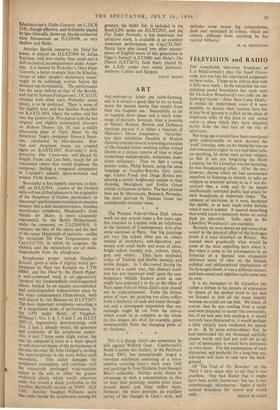A RT ART - HISTORICAL labels are habit-forming, and it is always a
good idea to try to break down the mental inertia that results from their too frequent use. Successfully to do so requires more space and a much wider range of pictures, however, than is possible at Messrs. Roland, Browse and Delbanco (perhaps anyway it is rather a function of Malraux's Music, Imaginaire). Neverthe- less their exhibition Parallels in Modern Painting contains several interesting examples of like-minded artists working within related idioms at a certain remove of time or place (sometimes independently, sometimes under direct influence). Thus we find a young painter today, Philip Sutton, using the same language as Gandier-Brzeska forty years ago, Lucien Freud and Diego Rivera em- ploying a similar heightened realism in their drawing, Modigliani and Emilio Greco similar stylisations in theirs. The best pictures here are by Marcoussis, Bonnard, Pelmeke; the fauve portrait by Duncan Grant has considerable curiosity-value.
•
The Princess Fahr-el-Nissa Zeid, whose work we saw several times a few years ago, has returned to London with an exhibition at the Institute of Contemporary Arts after some successes in Paris. Her big paintings are very big indeed (they are on rollers instead of stretchers), non-figurative, pat- terned with small blobs and areas of clean, bright colour (mostly reds, yellows, black, grey and white). They have reminded critics of Twicish and Arabic mosaics and textile designs. As I discovered durhig the course of a recent tour, this abstract tradi- tion has not impressed itself upon the con- temporary Middle Eastern artist as one might have expected it_to do, so the effect of Paris upon Fahr-el-Nissa Zeid's style should not be underestimated. From the formal point of view, her painting too often suffers from a similarity of scale and touch through- out and a consequent impression that any rectangle might be cut from the canvas which would be as complete as the whole (in this respect My Hell, for example, gains immeasurably from the changing pulse of its rhythms). • • This is a charge which can sometimes be laid against William Gear. Camberwell's South London Art Gallery, in the Peckham Road, SW5, has enterprisingly staged a two-man exhibition consisting of a retro- spective covering Gear's work since 1948 and paintings by Ivon Hitchens from Howard Bliss's collection. Neither artist shows to advantage in such a concentration as this (at least their paintings require more space around them) and Gear suffers most. However, the show provides an excellent survey of the changes in Gear's style, and includes some recent big compositions, dark and restrained in colour, which are entirely different from anything he has tackled hitherto.
M. H. MIDDLETON


































 Previous page
Previous page